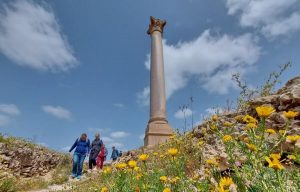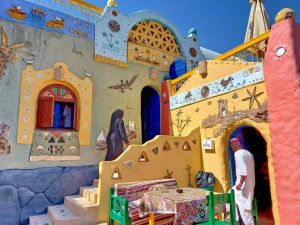A lion with a human head lies on the eastern side of the Giza plateau, with the pyramids in the backdrop, and is one of the world’s biggest sculptures. The planet’s oldest Sphinx was built by King Kephren; it is a single block of limestone that was previously attached to the main bedrock and is 20.5 meters tall, 73 meters long, and 6 meters wide.
The Sphinx Story:
When the pyramid of King Kephren was being built, limestone was taken from the area that today houses the Sphinx, and a large portion of the rock was ignored by the workers after being examined and shown to be of poor quality to be cut for the pyramid. After finishing construction work on the pyramid, this piece of rock was still blocking the view of the pyramid, which clearly irritated the king, who most likely gave orders to remove this rock so that the view of the pyramid would be unobstructed. The idea was then hatched to make a statue for the king instead, but the size and shape were inconvenient for making a typical royal statue sitting on a throne.
The choice was made then to construct this Sphinx with the king’s head and the forest’s king’s body “lion,” which may be defined as a combination of the lion’s physical power and the king’s intelligence power in one image. The Sphinx is at least 4500 years old; the bottom portion of the Sphinx has been tested and proven to be more than 10,000 years old, and it has stood throughout much of man king history in both situations.
The Dream Stele:
Between the Sphinx’s claws lies the Dream Stele, a slab of granite with hieroglyphs engraved on it that relates the narrative of Prince Thotmoses IV, who was once hunting in the Giza desert and fell asleep in the shadow of the Sphinx when the Sphinx was swallowed in sand save for its head. Thutmose IV had a dream in which he saw god offering him a new kingdom. Indeed, this deity was the Sphinx himself, as the ancient Egyptians recognized him as “the living image of God on earth.” Sshp-ankhw, a term given to royal sculptures of Dynasty IV (2575–2467 BC and thereafter) in the New Kingdom (c. 1570–1070 BC) and especially to the Great Sphinx. Although the term Sphinx is not phonetically similar to the work Sshp-ankw, it might be a mispronunciation by the Greek.
The face’s one-meter-wide nose is gone. Long rods or chisels were hammered into the nose, one down from the bridge and one beneath the nostril, and then used to pull the nose off towards the south, according to an examination of the Sphinx’s face.
The loss of the nose is attributed to iconoclasm by Muhammad Sa’im al-Dahr, a Sufi Muslim, according to the Egyptian Arab historian al-Maqrz, who wrote in the 15th century AD. Sa’im al-Dahr was incensed when he saw Egyptian peasants presenting sacrifices to the Sphinx in the hope of improving their harvest in AD 1378. He smashed the nose and was executed for vandalism. The Sphinx, according to Al-Maqrz, is the “talisman of the Nile,” on which the inhabitants believed the flood cycle was dependent.
There is also a legend that the nose was broken off by a cannonball thrown by Napoleon’s troops, which has survived to this day. Other variations accuse British soldiers, Mamluks, and others. However, drawings of the Sphinx created in 1737 and published in 1755 by Dane Frederic Louis Norden show the Sphinx without a nose.
A ceremonial pharaonic beard is supposed to have been affixed in addition to the missing nose, however, this might have been added later after the initial construction. According to Egyptologist Vassil Dobrev, if the beard had been an original component of the Sphinx, it would have injured the statue’s chin when it fell. The absence of apparent damage backs up his assumption that the beard was added later.






















